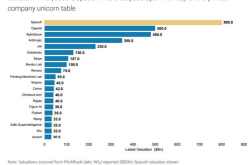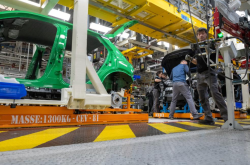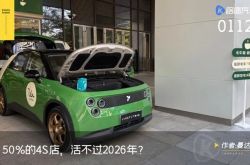WAIC 2025: Bridging the Gap to the AI Era's iPhone
![]() 08/05 2025
08/05 2025
![]() 443
443
Source | BohuFN
In the vibrant realm of technology, each significant event resembles a martial arts gathering on Mount Hua, where experts converge to display their prowess. The recently concluded 2025 World Artificial Intelligence Conference (WAIC 2025) stands as the most captivating focal point in the current technological landscape.
This WAIC not only set records for the highest number of visitors but also for the broadest scope of exhibiting companies, encompassing traditional internet giants like Baidu, Alibaba, and Tencent; established AI firms such as SenseTime and iFLYTEK; and unicorn enterprises like Zhipu, MiniMax, Jieyue Xingchen, and Yuezhideanmian.
Companies from diverse sectors gathered to showcase their strengths. Besides general and vertical large models and agent applications, numerous unexpected AI hardware and interactive products were on display, turning the event into a grand "AI carnival".
Large Models "Touching Down" on Earth
Over 60 intelligent robots navigated smoothly through the venue, each performing specific duties, while over 50 AI terminal products exhibited the diverse achievements of AI technology. At WAIC 2025, artificial intelligence is reshaping our lives and the world around us.
Unlike the "Hundred Models War" of the past two years, today's AI no longer merely pursues grandiose parameters but accelerates its integration into every aspect of social life, evolving from "usable" to "user-friendly" and "applicable".
In the realm of large models, leading enterprises like Alibaba, Tencent, Baidu, SenseTime, MiniMax, Jieyue Xingchen, and Yuezhideanmian unveiled their latest advancements. Not only has the pace of iteration accelerated, but the costs of training and inference have also been significantly reduced. The trend towards open-source large models has gained momentum, providing robust support for industry enterprises.
SenseTime introduced its new generation of multimodal reasoning large model, "Ririxin V6.5," which employs an image-text interleaved thinking chain design, enhancing reasoning capabilities while cutting costs by 70%. Alibaba, on the other hand, debuted three newly open-sourced large models and announced that Tongyi Qianwen has achieved full-size, full-modal comprehensive open-sourcing.
In addition to the thriving development of foundational large models, vertical industry large models have transformed into tangible "productivity" through deep cultivation of various subdivisions, precisely connecting and meeting users' landing needs.
Keling introduced new functions, Lingdong Canvas and Multi-Image Reference, which improved the model's effect by 102%, with notable enhancements in subject consistency, video effects, and image quality. Mianbi Intelligence focused on efficient end-side large models, showcasing applications in intelligent cockpits and robotics. Ant Financial Technology launched the financial reasoning large model, Agentar-Fin-R1.
In the domain of AI applications and agents, Alibaba presented the AI smart assistant Kuake, while Baidu integrated the capabilities of the Wenxin large model into various products, encompassing core offerings like AI search, digital human live streaming, Luobo Kuaipao, and Wenxin Kuaima.
Ant Group showcased its latest products integrating AI into medical, financial, and lifestyle scenarios; Kingsoft Office globally debuted the AI agent WPS Lingxi; and Zhipu AI displayed applications such as AutoGLM Meditative Agent and digital human interaction systems.
As AI accelerates its penetration into diverse application scenarios, "landing" has emerged as the primary theme for large model exhibitors. The deep integration of AI and hardware has become a prominent highlight of this WAIC, with the continuous increase in compatible hardware fostering a thriving AI ecosystem.
Alibaba launched its first self-developed AI glasses, "Quark Glasses," which are highly integrated into Alibaba's ecosystem, supporting high-frequency applications like Gaode Maps, Kan Yixia Payment, and Taobao price comparison. Additionally, AI glasses from brands like Rokid, Xiaomi, and LeTV made their debut, intensifying the "Hundred Glasses War".
The office sector is another key area of focus. Companies such as iFLYTEK, Future Intelligence, WISHEE, and Chumen Wenwen have all targeted conference and business scenarios, unveiling multiple smart hardware products equipped with AI large models, including headphones, office notebooks, voice recorders, and translation devices.
AI companion products brought a touch of "cuteness." SenseTime Technology's "Fuzozo" is an AI toy that can be nurtured, chatted with, and socialized. The Looi desktop robot is a "desktop pet" that perceives users' emotions and environment.
The robot exhibition area was undoubtedly the most popular attraction, with robots performing talent shows, making snacks, playing drums, and dancing dragons, showcasing endless variety. AI hardware products from startups were equally eye-catching, such as smart cupping devices and sound-sensing air drums. These seemingly ordinary items can seamlessly integrate into daily life, addressing users' minor pain points.
With the rapid evolution of artificial intelligence technology, the innovative implementation of AI has reached the level of C-end products. Compared to earlier years when smart hardware had numerous shortcomings, today's AI hardware has undergone substantial changes and improvements, transitioning from a mere "concept" to an essential vehicle for integrating AI into daily life.
The Imagination Space of AI Hardware
According to forecasts by Verified Market Research, the AI hardware market size is projected to reach $474.1 billion (approximately RMB 3.3895 trillion) by 2030, with an average annual growth rate of 38.73%.
This trend is not confined to the Chinese market. At this year's CES (Consumer Electronics Show in the United States), the number of AI hardware exhibits and their depth of integration with applications far surpassed previous years, epitomizing the accelerated global explosion of AI hardware.
Over the past year, the pace of global technology giants' forays into the AI hardware sector has significantly accelerated.
In May last year, ByteDance acquired the Shenzhen startup Oladance and launched its first AI agent earphones, "Ola Friend," in October. Since the beginning of this year, Xiaomi and Alibaba have both introduced AI glasses. For Alibaba, this marks its re-entry into the smart hardware sector after the previous round of AI speaker competition.
The layout of overseas giants is also picking up pace. Google announced the launch of smart glasses integrated with Gemini AI and supported by the Android XR underlying system. OpenAI followed suit by announcing the acquisition of the hardware startup IO, aiming to develop a new series of AI devices.
From the "Hundred Models War" to the "Hardware Competition," the strategic shift of technology giants underscores a profound return of AI technology from basic capability competition to scenario landing value.
Although the capabilities of large models among major companies are still uneven, from the user's perspective, general large models must ultimately be implemented in applications. Minor technological gaps are insufficient to create moats for applications and products. Therefore, major companies need to find alternative paths to convert technological dividends into products that can genuinely embed themselves into users' daily lives, solve practical pain points, and form usage dependence.
Firstly, explore the possibilities of commercialization and diverse monetization methods. Despite being the general trend, large AI models remain a business with "high investment and slow returns." While most AI-native applications have simultaneously launched paid membership mechanisms, free trials continue to dominate. Major companies are wary of user churn once charging commences.
This concern was also echoed in a ByteDance expert interview summary last year. Data revealed that each Doubao user would only engage in 3 to 4 rounds of conversation each time they opened the app. If their needs were not met within 2 minutes, they might switch to other applications.
This is because most current C-end AI applications suffer from homogenization issues, leading to low user loyalty and reluctance to pay, generally facing commercialization challenges.
In contrast, smart hardware already boasts a mature business model, with AI hardware such as headphones, glasses, and learning machines pioneering the commercialization stage.
Taking AI learning machines as an example, Luotu Technology predicts that sales of learning tablets in the Chinese market will reach 7.137 million units in 2025, marking a year-on-year increase of 20.5%. The "Hundred Glasses War" has also sparked a sales boom for AI glasses. In the first half of 2025, global sales of Meta smart glasses reached 1.26 million units, with sales surging by over 200% year-on-year.
Compared to AI applications, consumers are more willing to pay for AI hardware, as it provides a tangible product offering a more intuitive, immersive, and convenient user experience. For major companies, simple hardware sales can achieve initial commercialization, with sustainable revenue generated through content subscriptions, value-added services, and other methods.
Secondly, in the upcoming smart terminal ecosystem, seize traffic entrances and discourse power. Sam Altman, CEO of OpenAI, once mentioned a viewpoint where he believed that the potential of AI can only be truly unleashed if users "use AI in a natural way every day."
Regardless of how powerful large AI models are, they cannot function without hardware support. The interaction between hardware and users determines the user experience of large AI models. Hardware serves as the carrier of AI, but AI can also be constrained by hardware.
To date, many leading large models still reside within others' operating systems and hardware devices. Without breaking through the software-hardware barrier, it is difficult to fully unleash their capabilities. Moreover, large models "housed under others' roofs" face throttling, making it challenging to achieve a true commercial closed loop.
However, as AI hardware continues to "break the circle," technology giants have also sensed the opportunity to disrupt traditional hardware vendors. They are beginning to personally develop the next generation of smart devices, striving to occupy a pivotal position in the future AI ecosystem and becoming a new traffic distribution hub.
Alibaba CEO Wu Yongming also once stated, "The greatest imagination of AI is not to create one or two new super apps on mobile screens but to take over the digital world and change the physical world," which aligns with the direction internet giants are striving towards.
Major Companies Play It Safe First
While all industries stand to benefit from large models, in the realm of AI hardware, major companies and startups generally adopt a more pragmatic approach, expanding scale while optimizing the experience, and exploring the market through small, quick steps.
Firstly, internet giants focus on AI hardware products primarily in the field of consumer-grade terminal products, such as glasses, headphones, speakers, etc., which already possess a certain user base and are naturally closer to users. By fostering users' new usage habits, these AI hardware products are poised to become the new central nervous system of smart systems in the future, enabling cross-application and cross-device invocation through large models.
However, when major companies deploy consumer-grade smart products, groundbreaking disruptive innovations are rare. They mostly revert to first principles, with hardware as the core and AI as an added value, first establishing market scale before refining the ecosystem and products. This also reflects the immaturity of the AI hardware ecosystem.
Secondly, major companies' layout in AI smart hardware often involves the "buy, buy, buy" approach, extending around the upstream and downstream of their main businesses. This characteristic is particularly evident in Meituan and JD.com. According to incomplete statistics, in the first five months of 2025, financing in the embodied intelligence sector exceeded RMB 23 billion, with Meituan and JD.com accounting for over 30% of the investment.
Meituan and JD.com have coincidentally listed robots as their core investment direction, closely tied to the layout of the two platforms in the instant retail and takeout industries. For instance, JD.com's "Qixian Xiaochu" takeout direct-sales store utilizes the Meishanshi brand cooking robot from Xianglu Technology, which JD.com invested in during its A round and strategic round in 2023 and 2024, respectively.
A deeper consideration lies in the fact that intelligent robots can help platforms achieve cost reduction and efficiency enhancement, bolstering their core competitiveness. For example, Wang Xing of Meituan mentioned as early as 2017 that driverless technology and robots would be employed for delivery in the future. JD.com, which relies heavily on logistics, is also expected to optimize supply chain efficiency through innovative technologies such as large models and robots.
However, whether TOC or TOB, AI hardware is not yet fully mature. For instance, AI glasses still grapple with issues such as discomfort in wearing, redundant functions, lack of interaction, and ecosystem integration.
Moreover, there is currently no fully AI-oriented smart hardware on the market. It remains more of an innovation model of hardware + AI. The AI hardware product sector is still in its nascent stages. To become an industry disruptor, both opportunities and challenges coexist.
Although the booming development of the AI hardware industry has become an inevitable trend, for products to escape the fate of being ignored by users, it is insufficient to rely solely on hardware and AI gimmicks. They must also be integrated with AI applications, achieving continuous iteration and optimization towards the goal of ecological interconnection.
After all, the lessons learned from the previous "smart speaker war" have already warned the industry that the vast sea of technology must always anchor its coordinates to users' real needs to sail steadily and far.






